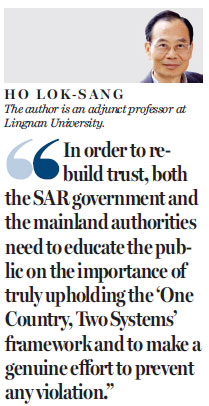Rebuilding trust between the mainland and Hong Kong
Updated: 2016-05-17 08:09
By Ho Lok-sang(HK Edition)
|
|||||||
There is so much mistrust between the mainland authorities and Hong Kong people that it has been extremely difficult to take advantage of the possible gains that may be achieved through greater integration between Hong Kong and Shenzhen. These can be looked upon as "twin cities" much like Minneapolis and Saint Paul in the United States and Buda and Pest forming Budapest in Hungary. Hong Kong, an international and cosmopolitan "world city", has a population of 7.3 million. It is well known for its connectivity to the world and its rule of law. Metropolitan Shenzhen, now the most innovative and competitive city in China, has a population of 18 million. The two cities, each with their unique strengths, can complement each other and scale new heights - with benefits to both.
In the 2008-09 Policy Address, then chief executive Donald Tsang Yam-kuen announced that DuPont decided to establish the Global Thin Film Photovoltaic Business/R&D Centre in the Hong Kong Science Park, and to set up production facilities in Shenzhen. He set his sights on "maximizing the benefits of the Shenzhen-Hong Kong Innovation Circle". In the policy address the following year, Tsang explained that "the governments of Hong Kong and Guangdong are formulating a framework agreement for Hong Kong-Guangdong cooperation The framework will also serve as an agenda for Hong Kong-Guangdong cooperation, laying a foundation for us to seek to incorporate the related initiatives into the national 12th Five-Year Plan (2011-2015)." In April 2009, a new policy of allowing multiple entries into Hong Kong for all mainlanders (other than some officials whose travel to Hong Kong needed special approval) who had registered residence in Shenzhen took effect. At the time, all these ideas were accepted by the Hong Kong public without causing uproar. Unfortunately, all this has changed. Today any suggestion of integration will certainly be looked upon with suspicion.
Against this backdrop, the policy of multiple entries into Hong Kong was suspended in April 2015. From then on, Shenzhen residents were allowed to visit Hong Kong no more than once a week. This was in response to a rising tide of protests against parallel traders whose activities were seen to have disrupted the lives of Hong Kong people living in towns such as Sheung Shui and Tuen Mun. These protests, along with various "mobile occupy" activities called "gouwu" - an obvious extension of the "Occupy Central" movement of 2014 - reflect an emerging hostility against mainland visitors. This in turn reflects an erosion of mutual trust between mainlanders and Hong Kong people.
Recently some tourist operators tried to bring back the policy of multiple-visit permit for Shenzhen residents. In view of the mistrust between the Hong Kong public and mainlanders, such a move could backfire. The SAR government is wise in making it clear it has no plan to bring back multiple-visit permit.
However, the SAR government may and should move in the right direction, albeit cautiously. Instead of one trip a week, which is a far cry from multiple visits, it can try two trips a week. If this is deemed acceptable and found not to cause any problems, then it can increase the quota further to, say, three trips a week.
In order to rebuild trust, both the SAR government and the mainland authorities need to educate the public on the importance of truly upholding the "One Country, Two Systems" framework and to make a genuine effort to prevent any violation.
Today most of the parallel traders, whose activities are disorderly and pose a nuisance to residents of new towns close to the border, are Hong Kong residents. Thus, suspending multiple visits from Shenzhen residents is really beside the point, but Hong Kong still needs to be sensitive to the public's concerns. Along with increasing the number of visits from one to two a week, the SAR government may do well to persuade the mainland authorities to perform due diligence at customs checkpoints to combat smuggling activities.
There is little doubt that working together is the way to go for our twin cities. But trying to achieve this quickly, without regard for the reality of the public's concerns, may well actually slow down integration. Officials also should avoid using language that may alienate people. Speaking on a radio program, Secretary for Financial Services and the Treasury Ceajer Chan Ka-keung said that those who are against integration may need to have their brains examined. Such language should be avoided.
We need to know that we are working on a very sensitive issue. For some reason, some people have become allergic to any ideas involving integration. Policymakers need to convince them that there is no conspiracy, and that any benefit from integration will find its way to the man in the street, and not fatten the purses of the wealthy. Thus, working by rules, increasing transparency, listening to and seriously addressing the concerns of people are all needed. We need to be patient, but we also must work in the right direction, taking one step at a time. Building trust is not easy; but destroying trust is. This much we have to remember.

(HK Edition 05/17/2016 page10)